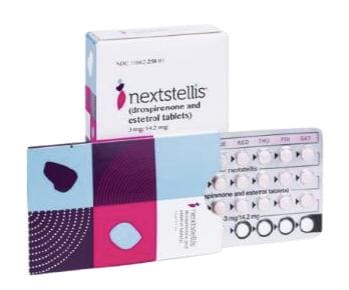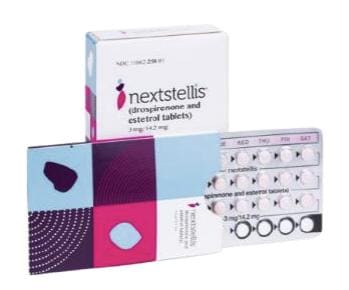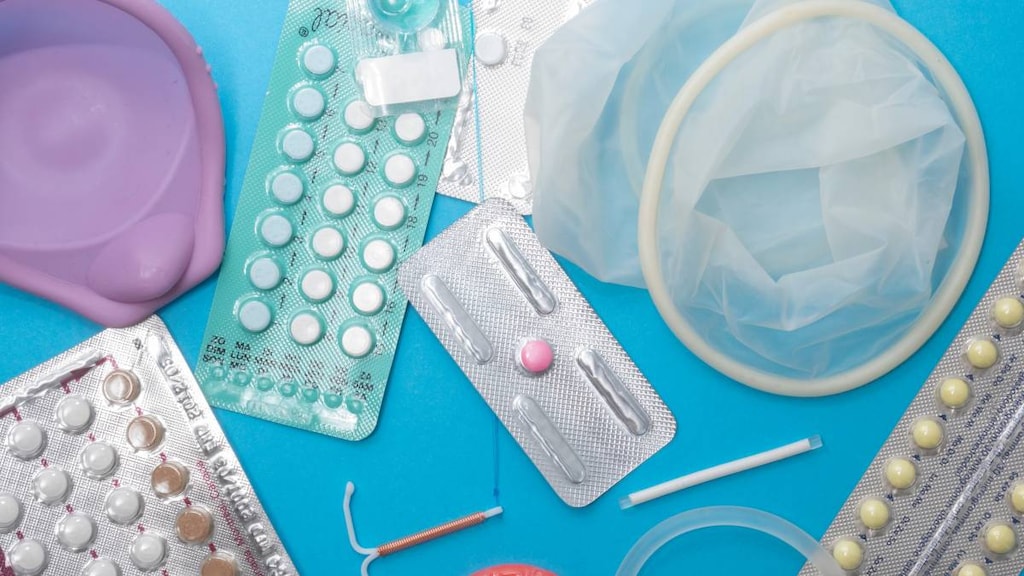What is Nextstellis?
- Nextstellis is a birth control pill (oral contraceptive) used by females to prevent pregnancy.
- Nextstellis does not protect against HIV infections (AIDS) and other sexually transmitted infections.
- Nextstellis may be less effective if you have a body mass index (BMI) of 30 or higher. In females with a BMI of 30 or higher, Nextstellis may become less effective as your BMI increases.
- It is not known if Nextstellis is safe and effective in females with a BMI of 35 or higher.
How does Nextstellis work for contraception?
Your chance of getting pregnant depends on how well you follow the directions for taking your birth control pills. The better you follow the directions, the less chance you have of getting pregnant.
Based on the results of one clinical study of a regimen of drospirenone 3 mg and estetrol 14.2 mg tablets, about 2 out of 100 females may get pregnant within the first year they use Nextstellis.
The following chart shows the chance of getting pregnant for females who use different methods of birth control. Each box on the chart contains a list of birth control methods that are similar in effectiveness. The most effective methods are at the top of the chart. The box on the bottom of the chart shows the chance of getting pregnant for females who do not use birth control and are trying to get pregnant.
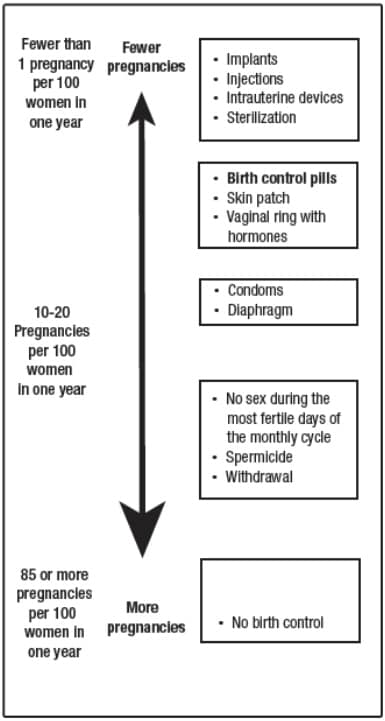
What is the most important information I should know about Nextstellis?
Do not use Nextstellis if you smoke cigarettes and are over 35 years old. Smoking increases your risk of serious cardiovascular side effects (heart and blood vessel problems) from birth control pills, including death from a heart attack, blood clots, or stroke. The risk increases with age and the number of cigarettes you smoke.
Who should not take Nextstellis?
Do not take Nextstellis if you:
- smoke and are 35 years of age and older.
- have or have had blood clots in your arms, legs, lungs, or eyes.
- have a problem with your blood that makes it clot more than normal.
- have certain heart valve problems or an irregular heartbeat that increases your risk of having blood clots.
- had a stroke.
- had a heart attack.
- have high blood pressure that cannot be controlled by medicine or have high blood pressure with blood vessel problems.
- have diabetes:
- with high blood pressure or kidney, eye, nerve, or blood vessel damage, or
- for more than 20 years.
- have certain kinds of severe migraine headaches with aura.
- have liver problems, including liver tumors.
- have any unexplained vaginal bleeding.
- have or have had breast cancer or any cancer that is sensitive to female hormones.
- have kidney disease or kidney failure.
- have reduced adrenal gland function (adrenal insufficiency).
- take any Hepatitis C drug combination containing ombitasvir/paritaprevir/ritonavir, with or without dasabuvir. This may increase levels of the liver enzyme "alanine aminotransferase" (ALT) in the blood.
If any of these conditions happen while you are taking Nextstellis, stop taking Nextstellis right away and talk to your healthcare provider. Use non-hormonal contraception when you stop taking Nextstellis.
What should I tell my healthcare provider before taking Nextstellis?
Before taking Nextstellis, tell your healthcare provider about all of your medical conditions, including if you:
- are scheduled for surgery. Nextstellis may increase your risk of blood clots after surgery. Talk to your healthcare provider about taking Nextstellis before and after your surgery or if you are going to be unable to walk for an extended period of time (immobilized).
- are depressed now or have been depressed in the past.
- had yellowing of your skin or eyes (jaundice) caused by pregnancy (cholestasis of pregnancy).
- are pregnant or think you may be pregnant.
- are breastfeeding or plan to breastfeed. Nextstellis may decrease the amount of breast milk you make. Nextstellis may pass into your breast milk. Talk to your healthcare provider about the best birth control method for you while breastfeeding.
Tell your healthcare provider about all the medicines you take, including prescription and over-the-counter medicines, vitamins, and herbal supplements. If you are currently on daily, long-term treatment for a chronic condition with any of the following medicines, you should talk to your healthcare provider before taking Nextstellis:
- CYP inducers (aprepitant, barbituates, bosentan, carbamazepine, efavirenz, felbamate, griseofluvin, oxycarbazepine, phenytoin, rifamptin, ribatin, topiramate, products containing St. John's wort, and others)
- CYP inhibitors (itraconazole, voriconazole, fluconazole, ketoconazole and others)
- HIV/hepatitis C virus protease inhibitors and non-nucleoside reverse transcriptase inhibitors (nelfinavir, ritonavir, boceprevir, telaprevir, indinavir, nevirapine, etravirine and others)
- Lamotrigine
- Potassium-sparing diuretics (spironolactone and others)
- Potassium supplementation
- Corticosteroids
Nextstellis may affect the way other medicines work, and other medicines may affect how well Nextstellis works.
Know the medicines you take. Keep a list of them to show your healthcare provider and pharmacist when you get a new medicine.
How should I take Nextstellis?
- Read the detailed Instructions for Use at the end of this Patient Information leaflet about the right way to take your Nextstellis.
What are the possible side effects of Nextstellis?
- Nextstellis may cause serious side effects including blood clots in your lungs, heart attack, or a stroke that may lead to death. Some other examples of serious blood clots include blood clots in the legs or eyes. Serious blood clots can happen especially if you smoke, are obese, have high blood pressure, have diabetes, have high cholesterol, or are older than 35 years of age. Serious blood clots are more likely to happen when you:
- first, start taking birth control pills
- restart the same or different birth control pills after not using them for a month or more
- leg pain that will not go away
- sudden severe shortness of breath
- sudden change in vision or blindness
- chest pain
- a sudden, severe headache unlike your usual headaches
- weakness or numbness in your arm or leg
- trouble speaking
Other serious side effects include:
- high potassium levels in your blood (hyperkalemia). Certain medicines and conditions can also increase the potassium levels in your blood. Your healthcare provider may check the potassium levels in your blood during treatment with Nextstellis. Call your healthcare provider or go to a hospital emergency room right away if you have signs or symptoms of high potassium levels in your blood including:
- weakness or numbness in an arm or leg
- palpitations (feel like your heart is racing or fluttering) or irregular heartbeat
- nausea
- vomiting
- severe pain in your chest
- shortness of breath
- high blood pressure. You should see your healthcare provider to check your blood pressure regularly.
- new or worsening headaches including migraine headaches.
- possible cancer that is sensitive to female hormones, such as breast cancer, skin cancer (melanoma), lung cancer, and brain cancer.
- liver problems, including:
- an increase in liver enzymes in the blood
- rare liver tumors
- jaundice. Call your healthcare provider if you have yellowing of your skin or eyes.
- changes in the sugar and fat (cholesterol and triglycerides) levels in your blood.
- gallbladder problems (cholestasis), especially if you previously had cholestasis of pregnancy.
- irregular or unusual vaginal bleeding or spotting between your menstrual periods, especially during the first 4 months of taking Nextstellis, or the absence of menstrual periods.
- Depression.
- possible cancer in your cervix.
- swelling of your skin especially around your mouth, eyes, and in your throat (angioedema). Call your healthcare provider right away if you have a swollen face, lips, mouth, tongue or throat, which may lead to difficulty swallowing or breathing. Your chance of having angioedema is higher if you have a history of angioedema.
- dark patches of skin around your forehead, nose, cheeks and around your mouth, especially during pregnancy (chloasma). Females who tend to get chloasma should avoid spending a long time in sunlight, tanning booths, and under sun lamps while taking Nextstellis. Use sunscreen if you have to be in the sunlight.
What are the most common side effects of Nextstellis?
The most common side effects of Nextstellis include:
- irregular vaginal bleeding (including absence of period)
- mood changes
- headache
- breast tenderness, pain, and discomfort
- pain with your periods
- acne
- weight gain
- decreased sex drive
These are not all of the possible side effects of Nextstellis.
Call your doctor for medical advice about side effects. You may report side effects to FDA at 1-800-FDA-1088.
Do birth control pills cause cancer?
Birth control pills do not seem to cause breast cancer. However, if you have breast cancer now, or have had it in the past, do not use birth control pills because some breast cancers are sensitive to hormones.
Females who use birth control pills may have a slightly higher chance of getting cervical cancer. However, this may be due to other reasons such as having more sexual partners.
What if I want to become pregnant?
You may stop taking the pill whenever you wish. Consider a visit with your healthcare provider for a pre-pregnancy checkup before you stop taking the pill.
What should I know about my period when taking Nextstellis?
Irregular vaginal bleeding or spotting may happen while you are taking Nextstellis, especially during the first 4 months of use. If the irregular vaginal bleeding or spotting continues or happens again after you have had regular menstrual cycles, call your healthcare provider. It is important to continue taking your pills on a regular schedule to prevent pregnancy.
What if I miss my scheduled period when taking Nextstellis?
Some females miss periods on hormonal birth control, even when they are not pregnant. However, if you go 2 or more months in a row without a period, or you miss your period after a month where you did not take all of your Nextstellis correctly, call your healthcare provider because you may be pregnant. Also, call your healthcare provider if you have symptoms of pregnancy such as morning sickness or unusual breast tenderness. Stop taking Nextstellis if you are pregnant.
What else should I know about taking Nextstellis?
If you are scheduled for any lab tests, tell your healthcare provider you are taking Nextstellis. Certain blood tests may be affected by Nextstellis.
Nextstellis Images
General information about the safe and effective use of Nextstellis
Medicines are sometimes prescribed for purposes other than those listed in a Patient Information leaflet. Do not use Nextstellis for a condition for which it was not prescribed. Do not give Nextstellis to other people, even if they have the same symptoms that you have. It may harm them.
You can ask your pharmacist or healthcare provider for information about Nextstellis that is written for health professionals.
How should I store Nextstellis?
- Store Nextstellis at room temperature between 68°F to 77°F (20°C to 25°C).
- Throw away unused Nextstellis through a take-back option, if available. You may also visit www.fda.gov/drugdisposal for FDA instructions for throwing away medicine in your household trash. Do not flush Nextstellis down the toilet.
- Keep Nextstellis and all medicines out of the reach of children.
What are the ingredients in Nextstellis?
Active ingredient: Pink tablets: drospirenone and estetrol
Inactive ingredients:
- Pink tablets: corn starch, lactose monohydrate, magnesium stearate, povidone, and sodium starch glycolate. Film-coating: hydrogenated cottonseed oil, hydroxypropyl cellulose, hypromellose, iron oxide red, talc, and titanium dioxide.
- White tablets: corn starch, lactose monohydrate, and magnesium stearate. Film coating: hydrogenated cottonseed oil, hydroxypropyl cellulose, hypromellose, talc, and titanium dioxide.
For more information, go to www.maynepharma.com or call 1-844-825-8500
Instructions for use
Nextstellis (NEXT ste LIS)
(drospirenone and estetrol tablets)
for oral use
Important Information about taking Nextstellis
- Take 1 pill every day at the same time. Take the pills in the order directed on your blister pack.
- Swallow both the pink pills and white pills whole. You may take Nextstellis with or without food.
- Do not skip your pills, even if you do not have sex often. If you miss pills (including starting the pack late) you could get pregnant. The more pills you miss, the more likely you are to get pregnant.
- If you have trouble remembering to take Nextstellis, talk to your healthcare provider. When you first start taking Nextstellis, spotting or light bleeding in between your periods may occur. Contact your healthcare provider if this does not go away after a few months.
- Some females miss periods on hormonal birth control, even when they are not pregnant. However, if you miss a period and have not taken Nextstellis according to the directions, or miss 2 periods in a row, or feel like you may be pregnant, call your healthcare provider. If you have a positive pregnancy test, you should stop taking Nextstellis.
- If you have vomiting or diarrhea (within 3 to 4 hours after you take a pink active pill), take a new pink active pill that was scheduled for the next day as soon as possible. If possible, take the new pink active pill within 12 hours of the time you usually take it. If you miss more than 2 pink active pills, follow the instructions for "What Should I do if I miss any Nextstellis pills?"
- If you have vomiting or diarrhea for more than 2 days (48 hours) in a row, or if you take certain medicines, including some antibiotics and some herbal products such as St. John's Wort, your pills may not work as well. Use an additional non-hormonal birth control method, such as condoms or spermicide, until you talk to your healthcare provider.
- Talk to your healthcare provider before you have major surgery. Be sure to use another form of non-hormonal birth control (such as condoms or spermicide) if your healthcare provider tells you to stop Nextstellis before your surgery.
Before you start taking Nextstellis
- Decide what time of day you want to take your pill. It is important to take it at the same time every day and in the order as directed on your blister pack.
- Have backup non-hormonal birth control (such as condoms or spermicide) available and an extra full pack of pills if possible.
When should I start taking Nextstellis?
If you start taking Nextstellis and you have not used a hormonal birth control method before:
- Start on the first day (Day 1) of your natural menstrual period (Day 1 Start).
You do not need a back-up non-hormonal birth control method.
- If you start taking Nextstellis on any day other than the first day of your natural menstrual period, use a back-up non-hormonal birth control method (such as condoms or spermicide) until you have taken one (1) active (pink) pill every day for seven (7) days.
If you start taking Nextstellis and you are switching from another birth control pill:
- Start your new Nextstellis pack on the same day that you would start the next pack of your previous birth control method.
- Do not continue taking the pills from your previous birth control pack.
If you start taking Nextstellis and previously used a vaginal ring or transdermal patch:
- Start using Nextstellis on the day you would have reapplied the patch or inserted the vaginal ring.
If you start taking Nextstellis and you are switching from a progestin-only method such as an implant or injection:
- Start taking Nextstellis on the day of removal of your implant or on the day when you would have had your next injection.
If you start taking Nextstellis and you are switching from an intrauterine device or system (IUD or IUS):
- Start taking Nextstellis on the day of removal of your IUD or IUS.
- You do not need a non-hormonal back-up birth control method if your IUD or IUS is removed on the first day (Day 1) of your period. If your IUD or IUS is removed on any other day, use a non-hormonal back-up birth control method such as condoms or spermicide for the first 7 days that you take Nextstellis.
If you start taking Nextstellis after you have given birth and you were more than 20 weeks pregnant:
- Do not start Nextstellis earlier than 4 weeks after you have given birth.
- If your menstrual cycles have returned, see "If you start taking Nextstellis and you have not used a hormonal birth control method before".
- If your menstrual cycles have not returned, use additional non-hormonal birth control (such as condoms or spermicide) for the first 7 days that you take Nextstellis.
If you start taking Nextstellis after an abortion or miscarriage and you were 14 weeks pregnant or less:
- If within the first 7 days of abortion or miscarriage:
- Use additional non-hormonal birth control such as condoms or spermicide for the first 7 days you take Nextstellis.
- After the first 7 days following an abortion or miscarriage:
If you start taking Nextstellis after an abortion or miscarriage and you were more than 14 weeks pregnant but 20 weeks pregnant or less:
- Start Nextstellis after 4 weeks following the abortion or miscarriage.
- If your menstrual cycles have returned, see "If you start taking Nextstellis and you have not used a hormonal birth control method before".
- If your menstrual cycles have not returned, use additional non-hormonal birth control (such as condoms or spermicide) for the first 7 days you take Nextstellis.
Keep a calendar to track your menstrual period. If this is the first time you are taking birth control pills, read, "When should I start taking Nextstellis?" above and follow these instructions.
Before you start taking your pills
- Decide what time of day you want to take your pill. It is important to take it at about the same time every day.
- Look at your Nextstellis pill pack. See the figure below. The pill pack has 24 "active" pink pills (with hormone) to take for 3 weeks and 3 days, followed by 4 "inactive" white pills (without hormone).
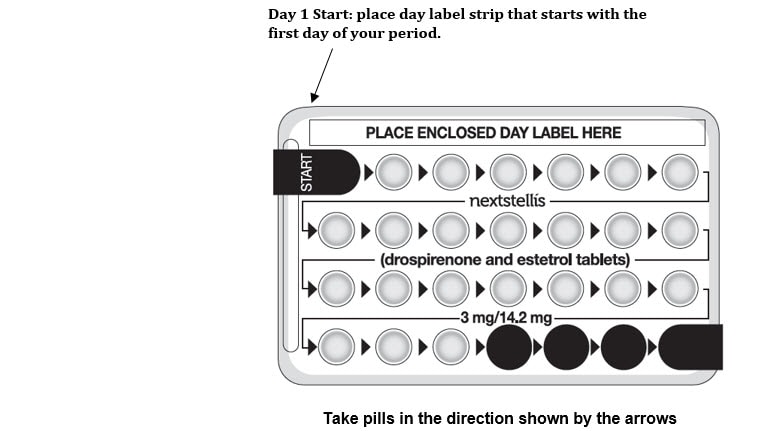
When to start the first pack of pills
Start on the first day (Day 1) of your natural menstrual period (Day 1 start). Pick a time of day which will be easy to remember.
Day 1 Start:
- Pick the day label strip that starts with the first day of your period.
- Place this day label strip on the pill dispenser over the area that says: "Place enclosed day label here".
- Take the first active pink pill of the first pack during the first 24 hours of your period. Take 1 pill every day in the order of the blister pack, at the same time each day, for 28 days.
- The day after taking the last pill on Day 28 from the blister pack, start taking the first pill from the new pack, on the same day of the week as the first pack. Take the first pill in the new pack whether or not you are having your period.
What should I do if I miss any Nextstellis pills?
If you miss 1 pink active pill in Weeks 1, 2 or 3, follow these steps:
- Take it as soon as you remember. Take the next pill at your regular time. This means you may take 2 pills in 1 day.
- Then continue taking 1 pill every day until you finish the pack.
- You do not need to use a back-up non-hormonal birth control method if you have sex.
If you miss 2 or more pink active pills in Week 1 or Week 2 of your pack, follow these steps:
- Take 1 missed pill as soon as possible and take the pill scheduled for the current day (which means you will take 2 pills in 1 day).
- Throw away the other missed pills.
- Then continue taking 1 pill a day until the pack is finished.
- Use a back-up non-hormonal birth control method (such as condoms or spermicide) if you have sex during the first 7 days after missing your pills.
If you miss 2 pink active pills in a row in week 3 of your pack, follow these steps:
- Take 1 missed pill as soon as possible and take the pill scheduled for the current day (which means you will take 2 pills in 1 day).
- Throw away the other missed pills.
- Continue taking 1 pill a day until you finish the pink active pills in the pack. Then throw away the inactive white pills in the pack.
- Start a new pack of pills the next day.
- If you miss your period this month, call your healthcare provider because you might be pregnant.
- You could become pregnant if you have sex during the first 7 days after you restart your pills. You should use a back-up non-hormonal birth control method (such as condoms or spermicide) if you have sex during the first 7 days after you restart your pills.
If you miss 1 or more white inactive pills, follow these steps:
- Skip the missed pill days.
- Continue taking 1 pill a day until the pack is finished.
If you have any questions or are unsure about the information in this leaflet, call your healthcare provider. They have a more technical leaflet called the Professional Labeling which you may read.
Instructions for use approved 04/2021.

